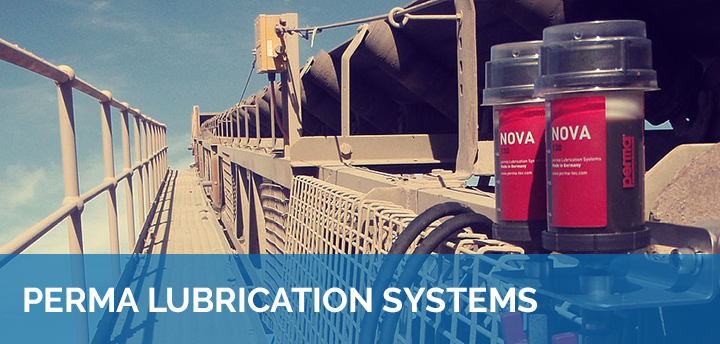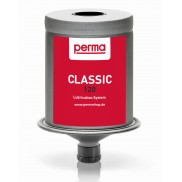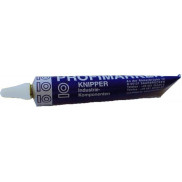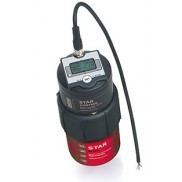tax incl.
Current offers
tax incl.
tax incl.
tax incl.
tax incl.
tax incl.
In industry, lubricants are indispensable aids that counteract wear and tear caused by friction and power transmission of machines and tools. They also protect against corrosion and cool the machine parts used and release exactly the required amount of lubricant.
Automatic lubricators supply the work parts safely and reliably with the required lubricants without any expenditure of time and control. They are available in various designs and sizes and can be selected in electric or gas-powered form as required.
Refillable lubricators are particularly clean and environmentally friendly. They are easy to install and activate through a chemical reaction when the activation screw is screwed in.
The running time of a lubricant dispenser depends on the ambient temperature as well as the quantity that the dispenser dispenses. The dispensers can be used for lubricants at temperatures from -15 °C to +65 °C. The dispensers can also be used for lubricants at temperatures from -15 °C to +65 °C.
Lubricant dispensers can be used in the food and beverage industry, in water and waste water technology, but also in machine and equipment construction, as well as in elevator and lifting technology.
The lubricators can be used universally and can be filled with greases for the automotive industry as well as with food-safe lubricants for drinking water hygiene.
They work fully automatically, are robust, reliable and prevent damage to machines and workpieces, thus reducing costs. Complex repairs and associated production stoppages are prevented.
Bellows are elastic hoses, which are attached like accordions to movable machine parts for protection. They are usually made of plastic, leather or rubber and are intended to protect sensitive machines from contamination from the environment.
Bellows are used in different sizes, so they are known for example from washing machines in smaller form, but also in multi-part vehicles, such as articulated buses they are often seen.
In industry, bellows are mainly used as air ducts between two moving machine parts, which rub against each other during operation. They are also used to protect spindles or guideways.
Another variant of the bellows is the thin metal version. In this form they are used as compensation elements in pipeline construction or to protect pressure vessels.
Bellows are also called axle boots and are an important aid in the chemical industry. They are used here to seal moving valves. The bellows should hermetically seal the valves against stationary, i.e. fixed components.
In summary, it can be said that the aim when using bellows is always to protect mechanical components or systems in order to prevent contamination or external influences. In pipeline construction, they primarily serve to compensate for thermal expansion. Multilayer bellows are usually used as a safety function. Even if one layer is defective, the medium, often dangerous or toxic, is protected by the other layers or prevented from escaping.
Markings are ubiquitous in everyday business life and in most cases very important, if not vital. If you think of the roadway and road markings, you can imagine what would happen if there were suddenly no more markings.
But markings are also indispensable in industry. They point out dangers on the company premises and are necessary for a wide variety of work requirements.
These markings can be marked in different ways; as parking space markings, floor markings or marking signs that can be placed on floors or walls.
They visually highlight certain areas or serve as markings in production technology. Markings indicate boundaries or serve to guide or mark certain areas.
A marking can be applied with waterproof paint, cold plastic, thermoplastic or in the form of a special film. All these materials are designed to withstand all conditions such as weather, wear and tear from vehicles or the walking race in a durable and robust way, even when in constant use. Such markings are particularly well known on roads and motorways, car parks and multi-storey car parks, shopping centres and sports halls or also as playing field markings on sports fields.
Markings can be made by the respective industrial company itself using floor marking tapes or marking equipment, depending on the use and, above all, the size of the area. However, the marking of roads or public places is usually carried out by specialised companies. This is especially necessary if the marking is standardized by law.
Hydraulic seals are available in different versions and are used for different purposes. They all have the same basic function: to prevent mass transfers from leaving a room or to limit a deliberate exit. Hydraulic machines always operate under a certain pressure and must therefore be specially sealed. For this reason, they are usually either made entirely of a rubber/fabric mixture or solid rubber seals are reinforced with a fabric, i.e. coated.
The shape of hydraulic seals can also vary depending on the application.
Rod seals are used for hydraulic cylinders or piston rods. They are designed to prevent hydraulic fluid from escaping where the piston rod enters or leaves the cylinder.
Piston seals are responsible for sealing two separate cylinder chambers from one piston. Here again a distinction is made between single and double sealing effect.
With heavy and large machines, as used in industry, single seals are usually not sufficient to withstand the high load and strong pressure over a longer period of time. Therefore, depending on operating conditions, whole sealing systems are often used. These consist of guides, wipers and symmetrical lip seals.
The purpose of guides is to guide the piston and the piston rod in such a way that metallic contact between the individual components is prevented.
Wipers protect the hydraulic cylinder from dirt, moisture or foreign particles They wipe off foreign bodies from the piston rod to prevent contamination and possible defects.
With their shortened outer sealing lip, symmetrical lip seals replace both rod seals and piston seals.
Packing cords are used as sealing material in industry, but also in trade. They usually consist of braided fibre material and are covered with PTFE, graphite or aramid yarn. Packing cords are impregnated with greasing substances to improve the sealing effect and reduce friction between the individual parts.
The main use of packing cords is in the handling of valves or pumps which have the task of transporting water. They are inserted spirally into a stuffing box and then pressed onto the desired preload with the so-called stuffing box gland.
Today, packing cord is mainly used in mechanical engineering. It serves as a sealing element for boilers in which a liquid, vapour or gas pressure is created. For example, a moving rod inside a housing or a rotating shaft is sealed to prevent the medium from escaping.
Other uses of packing cords are found in agriculture or in industrial agitators and pumps. They are used to seal the spindle, which is located in control and regulating valves. In the past, packing cords were widely used in the piston steam engines of steam locomotives or in ship propulsion systems. However, these were mixed with asbestos, which has largely disappeared from production today and has been replaced by modern components.
Chemical maintenance products are the generic term for all lubricants, adhesives and sealants. These are used in workshops and industries for the maintenance or cleaning of machines and technical equipment. Chemical maintenance products are used for bonding, sealing, joining, lubricating, damping, sealing and cleaning in engineering and can be quite different in type and use.
Especially in the processing of gas, water, petrol or acidic materials a technically perfect sealing of the machines is very important. Chemical maintenance products must be able to withstand the complex requirements of ongoing maintenance in the industrial sector. Operating conditions under extreme temperatures and pressure loads are a daily challenge in industry. Furthermore, machines and tools are constantly exposed to everyday environmental influences such as dust, wear and tear and possibly different weather conditions. In order to avoid damage to people and the environment, it is therefore essential that processing runs smoothly and without incidents.
Special chemical maintenance products are required for processing in the food industry or for the supply of drinking water. They are solvent-free and harmless to humans.
Depending on the recyclable material, different products are available. Different release agents, lubricants, adhesives or sealants are used in metal processing than in plastics or glass processing. The product range in chemical maintenance products is huge and, depending on the manufacturer, very versatile.
The aim of these products is to delay machine wear and to guarantee smooth and safe operation.
In industry, lubricants are indispensable aids that counteract wear and tear caused by friction and power transmission of machines and tools. They also protect against corrosion and cool the machine parts used and release exactly the required amount of lubricant.
Automatic lubricators supply the work parts safely and reliably with the required lubricants without any expenditure of time and control. They are available in various designs and sizes and can be selected in electric or gas-powered form as required.
Refillable lubricators are particularly clean and environmentally friendly. They are easy to install and activate through a chemical reaction when the activation screw is screwed in.
The running time of a lubricant dispenser depends on the ambient temperature as well as the quantity that the dispenser dispenses. The dispensers can be used for lubricants at temperatures from -15 °C to +65 °C. The dispensers can also be used for lubricants at temperatures from -15 °C to +65 °C.
Lubricant dispensers can be used in the food and beverage industry, in water and waste water technology, but also in machine and equipment construction, as well as in elevator and lifting technology.
The lubricators can be used universally and can be filled with greases for the automotive industry as well as with food-safe lubricants for drinking water hygiene.
They work fully automatically, are robust, reliable and prevent damage to machines and workpieces, thus reducing costs. Complex repairs and associated production stoppages are prevented.
Bellows are elastic hoses, which are attached like accordions to movable machine parts for protection. They are usually made of plastic, leather or rubber and are intended to protect sensitive machines from contamination from the environment.
Bellows are used in different sizes, so they are known for example from washing machines in smaller form, but also in multi-part vehicles, such as articulated buses they are often seen.
In industry, bellows are mainly used as air ducts between two moving machine parts, which rub against each other during operation. They are also used to protect spindles or guideways.
Another variant of the bellows is the thin metal version. In this form they are used as compensation elements in pipeline construction or to protect pressure vessels.
Bellows are also called axle boots and are an important aid in the chemical industry. They are used here to seal moving valves. The bellows should hermetically seal the valves against stationary, i.e. fixed components.
In summary, it can be said that the aim when using bellows is always to protect mechanical components or systems in order to prevent contamination or external influences. In pipeline construction, they primarily serve to compensate for thermal expansion. Multilayer bellows are usually used as a safety function. Even if one layer is defective, the medium, often dangerous or toxic, is protected by the other layers or prevented from escaping.
Markings are ubiquitous in everyday business life and in most cases very important, if not vital. If you think of the roadway and road markings, you can imagine what would happen if there were suddenly no more markings.
But markings are also indispensable in industry. They point out dangers on the company premises and are necessary for a wide variety of work requirements.
These markings can be marked in different ways; as parking space markings, floor markings or marking signs that can be placed on floors or walls.
They visually highlight certain areas or serve as markings in production technology. Markings indicate boundaries or serve to guide or mark certain areas.
A marking can be applied with waterproof paint, cold plastic, thermoplastic or in the form of a special film. All these materials are designed to withstand all conditions such as weather, wear and tear from vehicles or the walking race in a durable and robust way, even when in constant use. Such markings are particularly well known on roads and motorways, car parks and multi-storey car parks, shopping centres and sports halls or also as playing field markings on sports fields.
Markings can be made by the respective industrial company itself using floor marking tapes or marking equipment, depending on the use and, above all, the size of the area. However, the marking of roads or public places is usually carried out by specialised companies. This is especially necessary if the marking is standardized by law.
Hydraulic seals are available in different versions and are used for different purposes. They all have the same basic function: to prevent mass transfers from leaving a room or to limit a deliberate exit. Hydraulic machines always operate under a certain pressure and must therefore be specially sealed. For this reason, they are usually either made entirely of a rubber/fabric mixture or solid rubber seals are reinforced with a fabric, i.e. coated.
The shape of hydraulic seals can also vary depending on the application.
Rod seals are used for hydraulic cylinders or piston rods. They are designed to prevent hydraulic fluid from escaping where the piston rod enters or leaves the cylinder.
Piston seals are responsible for sealing two separate cylinder chambers from one piston. Here again a distinction is made between single and double sealing effect.
With heavy and large machines, as used in industry, single seals are usually not sufficient to withstand the high load and strong pressure over a longer period of time. Therefore, depending on operating conditions, whole sealing systems are often used. These consist of guides, wipers and symmetrical lip seals.
The purpose of guides is to guide the piston and the piston rod in such a way that metallic contact between the individual components is prevented.
Wipers protect the hydraulic cylinder from dirt, moisture or foreign particles They wipe off foreign bodies from the piston rod to prevent contamination and possible defects.
With their shortened outer sealing lip, symmetrical lip seals replace both rod seals and piston seals.
Packing cords are used as sealing material in industry, but also in trade. They usually consist of braided fibre material and are covered with PTFE, graphite or aramid yarn. Packing cords are impregnated with greasing substances to improve the sealing effect and reduce friction between the individual parts.
The main use of packing cords is in the handling of valves or pumps which have the task of transporting water. They are inserted spirally into a stuffing box and then pressed onto the desired preload with the so-called stuffing box gland.
Today, packing cord is mainly used in mechanical engineering. It serves as a sealing element for boilers in which a liquid, vapour or gas pressure is created. For example, a moving rod inside a housing or a rotating shaft is sealed to prevent the medium from escaping.
Other uses of packing cords are found in agriculture or in industrial agitators and pumps. They are used to seal the spindle, which is located in control and regulating valves. In the past, packing cords were widely used in the piston steam engines of steam locomotives or in ship propulsion systems. However, these were mixed with asbestos, which has largely disappeared from production today and has been replaced by modern components.
Chemical maintenance products are the generic term for all lubricants, adhesives and sealants. These are used in workshops and industries for the maintenance or cleaning of machines and technical equipment. Chemical maintenance products are used for bonding, sealing, joining, lubricating, damping, sealing and cleaning in engineering and can be quite different in type and use.
Especially in the processing of gas, water, petrol or acidic materials a technically perfect sealing of the machines is very important. Chemical maintenance products must be able to withstand the complex requirements of ongoing maintenance in the industrial sector. Operating conditions under extreme temperatures and pressure loads are a daily challenge in industry. Furthermore, machines and tools are constantly exposed to everyday environmental influences such as dust, wear and tear and possibly different weather conditions. In order to avoid damage to people and the environment, it is therefore essential that processing runs smoothly and without incidents.
Special chemical maintenance products are required for processing in the food industry or for the supply of drinking water. They are solvent-free and harmless to humans.
Depending on the recyclable material, different products are available. Different release agents, lubricants, adhesives or sealants are used in metal processing than in plastics or glass processing. The product range in chemical maintenance products is huge and, depending on the manufacturer, very versatile.
The aim of these products is to delay machine wear and to guarantee smooth and safe operation.
OUR PRODUCT RECOMMENDATIONS
tax incl.
tax incl.
tax incl.
tax incl.



.png)
.png)

.png)
.png)




















